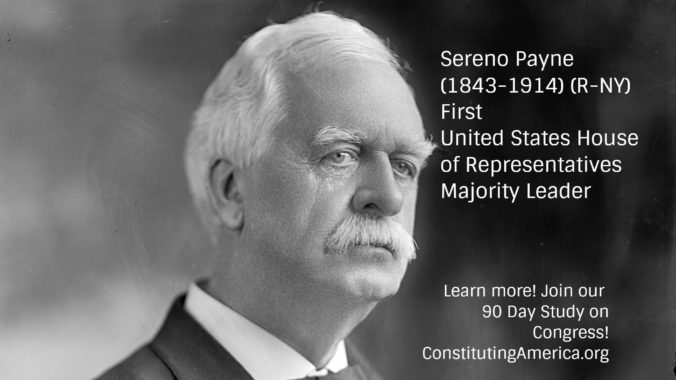Roles: House Speaker, President Of The Senate, Majority, Minority Leaders And Whips For An Effective Congress, Part 2
LISTEN ON SOUNDCLOUD:
Along with House Speaker and President of the Senate, other important positions such as Majority and Minority Leaders, and Whips play significant roles for an effective Congress. At the outset of United States Congresses, such roles were not as formal as they are today, and have come to be defined by history and tradition. However, since the House of Representatives is a large body, having floor leadership is especially beneficial to assist members with conducting business they were elected to complete, and help one another work at their best together.
House and Senate Majority Leaders are selected for the party that has the most Members elected to the current Congress. The Minority Leader is selected for the party with the fewer Members elected to the current Congress. Each is chosen within the respective party caucus or conference every two years at the start of a new Congress.
Representative Sereno Payne (R-NY) served as chairman of the Ways and Means Committee prior to becoming the first House Majority Leader in 1899. For the current, 115th Congress, serving as House Majority Leader is Representative Kevin McCarthy (R-CA). Early on, the tendency was a chairman of Ways and Means or Appropriations was asked to also serve as Majority Leader. This trend continued until the role became more distinct. While party floor leaders are not included in the Constitution, the positions developed over time. The first floor leaders for Democrats were official in 1920, and for Republicans in 1925.
Charged with scheduling legislation to be considered for a floor vote, planning short and long-term legislative agendas, and checking with Members to see how votes could go, the Majority Leader helps the party reach its goals as elected. In Congress, the “floor” is where House and Senate Members meet, discuss, and vote in favor of or against passage of legislation. Each floor is said to be in the House chamber or Senate chamber, with each chamber located on opposite sides inside the United States Capitol building in Washington, DC.
Minority Leaders serve as floor leaders like the Majority Leaders. Though many of the Minority Leader responsibilities are similar to those of the Majority Leader, the Minority Leader represents the minority party of the current Congress, speaks for and protects the rights of the minority party.
James Richardson (D-TN) was recognized as the first House Minority Leader in 1899, though it was said James Madison served as the first Minority Leader as he led the “loyal opposition” to Treasury Secretary Alexander Hamilton’s policies during the First Congress. Today, Representative Nancy Pelosi (D-CA) serves as House Minority Leader.
Senate floor leaders came from standing committees that had the most power. In 1913, Senator John Worth Kern (D-IN) functioned similarly as a Senate Majority Leader would now for the Democratic Party. The same occurred for the Republican Party in 1919 with Senator Henry Cabot Lodge, Sr. (R-MA) acting as a majority floor leader. Later, official elections of Senate Majority and Minority Leaders arrived first in 1920 with the Democratic Party choosing Oscar Underwood (D-AL) as Senate Minority Leader, and in 1925, the Republicans choosing Senator Charles Curtis (R-KS) as Senate Majority Leader. Senator Mitch McConnell (R-KY) serves today as Senate Majority Leader and the current serving Senate Minority Leader is Senator Charles Ellis “Chuck” Schumer (D-NY).
Similar to Majority and Minority House and Senate leaders, Whips, borrowed from the British Parliament and a foxhunting term, or “whipper-in” would assist floor leaders with keeping the legislative agenda moving, counting Members for votes and ensuring quorums, and standing in for floor leaders as needed. Whips, also elected by both parties, are still part of floor leadership in modern Congresses, positions that grew out of necessity to maintain order during congressional proceedings.
The first Democratic Party Whip elected was in 1913, Senator James Hamilton (D-IL). In 1915, the same Whip role was created by Republicans who elected Senator James Wolcott, Jr., Wadsworth (R-NY). Currently, Senator John Cornyn (R-TX) serves as Senate Majority Whip, and Senator Richard Durbin (D-IL) serves as the Senate Minority Whip. The current serving House Majority Whip is Representative Steve Scalise (R-LA), and the House Minority Whip is Representative Steny Hoyer (D-MD).
By now, leadership roles of Congress have developed further with Parliamentarians, conferences and caucuses, Sergeants at Arms, Doorkeepers, Chaplains, among others. These also assist with maintaining order and effectiveness so those elected may arrive to their respective offices and serve as promised.
The various roles established throughout the course of American history are proving effective though some want to rid America’s Congress of its Members almost immediately after an election. However, made up of imperfect people who would fail at times yet try again, America’s Founders and Constitution Framers showed up for known, imminent challenges, and against just about impossible odds to succeed. They did so believing something better could exist and pursued a new type of governing that if maintained by the electorate would offer the most freedom for those it represented.
Amanda Hughes serves as Outreach Director, and 90 Day Study Director, for Constituting America. She is the author of Who Wants to Be Free? Make Sure You Do!, and a story contributor for the anthologies Loving Moments(2017), and Moments with Billy Graham(forthcoming).
Sources:
“United States House of Representatives Majority Leaders of the House (1899 to present)”
http://history.house.gov/People/Office/Majority-Leaders/
“The Role of the House Minority Leader: An Overview” https://www.everycrsreport.com/reports/RL30666.html
“Role of Senate Minority Leader”
https://constitution.laws.com/senate/minority-leader
“United States House of Representatives Leadership”
https://www.house.gov/leadership
“The People of the People’s House”
http://history.house.gov/People/
“Floor Leaders, Majority and Minority Leaders, Party Whips” https://www.senate.gov/artandhistory/history/common/briefing/Leaders_Whips.htm
“The Role of the House Majority Leader: An Overview” http://congressionalresearch.com/RL30665/document.php?study=The+Role+of+the+House+Majority+Leader+An+Overview
“United States Senate Leadership & Officers”
http://www.senate.gov/senators/leadership.htm
“United States Senate Majority and Minority Leaders” https://www.senate.gov/artandhistory/history/common/briefing/Majority_Minority_Leaders.htm
“United States Senate Party Whips” https://www.senate.gov/artandhistory/history/common/briefing/Party_Whips.htm




Thank you. PSD